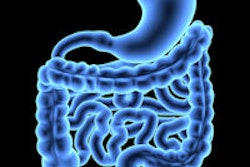
Ultrasound contrast agents aren't just for diagnostic use anymore. They can also be used therapeutically to help restore blood flow and salvage heart tissue in patients with one of the most serious types of heart attacks: ST-elevation myocardial infarction (STEMI), according to a study published this week in the Journal of the American College of Cardiology.
A team from the University of São Paulo Medical School in Brazil and the University of Nebraska Medical Center found that STEMI patients who received ultrasound impulses at a high mechanical index (HMI) after receiving ultrasound contrast had significantly better early coronary artery patency, microvascular recovery, and left ventricular function than those who didn't receive the treatment prior to percutaneous coronary intervention (JACC, May 31, 2016, Vol. 67:21, pp. 2506-2515).
"Intermittent diagnostic HMI transthoracic impulses, administered during an intravenous commercially available ultrasound contrast agent infusion, can safely improve early epicardial patency rates and recovery of microvascular function when utilized in the emergent contemporary management of patients with acute STEMI," wrote the team led by Dr. Wilson Mathias of the University of São Paulo.
Restoring flow
Patients with acute STEMI benefit from recanalization therapies such as pharmacological thrombolysis or percutaneous coronary intervention (PCI), which aim to restore epicardial flow as soon as possible, according to the researchers. However, these therapies can be associated with delays or lack of access to treatment. What's more, persistent microvascular obstruction can linger in more than half of patients following epicardial recanalization, "resulting in higher necrotic area, adverse left ventricular (LV) remodeling, and worse prognosis," they wrote
Mechanical index is defined as a measure of the bioeffect of an ultrasound beam, with a higher mechanical index indicating that the beam has a greater effect. The U.S. Food and Drug Administration (FDA) has stipulated that diagnostic ultrasound scanners cannot exceed a mechanical index of 1.9.
The researchers noted that previous clinical trials on animal models had demonstrated that high mechanical index impulses from a diagnostic ultrasound transducer during intravenous ultrasound contrast infusion might restore epicardial and microvascular flow in acute STEMI. As a result, the group now sought to assess the safety and efficacy of this adjunctive approach in humans.
In a study performed from May 2014 through September 2015, 100 patients with their first acute STEMI were randomized into three groups. In the first group, 20 patients received intermittent high mechanical index impulses at an index of 1.1 to 1.3 from a diagnostic ultrasound transducer just prior to emergent PCI. They also received the HMI impulses for an additional 30 minutes following PCI.
The second group of 10 patients received low mechanical index imaging, at an index of 0.18, for perfusion assessments before and after PCI. All patients received intravenous injection of the Definity (Lantheus Medical Imaging) ultrasound contrast agent prior to their ultrasound exams.
The remaining 70 patients arrived outside of the time window for ultrasound availability and only received emergency PCI. This patient cohort served as the control group for the study. There wasn't a statistically significant difference in the median door-to-dilation times for each of the three patient groups.
Of the three patient groups, those who received HMI impulses had the highest rate of recanalization as seen on angiography prior to PCI:
- High mechanical index impulses and PCI: 12/20 (60%)
- PCI-only treatment: 16/70 (23%)
- Low mechanical index imaging and PCI: 1/10 (10%)
The differences were statistically significant (p = 0.002).
The patients who received the therapeutic ultrasound contrast application also had better results one month after treatment. While there were no differences in obstructed microvascular segments before treatment, those who received the therapeutic ultrasound contrast application had significantly greater improvements in their myocardial perfusion score (p < 0.05). Those patients also had smaller proportions of obstructed segments at one month (p = 0.001) and significant improvements in left ventricular ejection fraction (p < 0.005).
"This improvement may be related to the long-term effects of restoring microvascular flow early in the treatment period," the authors wrote. "By acutely improving microvascular flow in acute STEMI, [diagnostic ultrasound] also may play a critical supplemental role in preventing the remodeling that leads to further reductions in ejection fraction and increased risk for arrhythmic and heart failure complications."
Large-scale trials are now needed to determine if this method can be used to improve ventricular function and clinical outcomes in acute STEMI patients, according to the researchers.
'Groundbreaking' research
In an accompanying editorial published in the same issue of the journal, noted ultrasound contrast advocate Dr. Steven Feinstein of Rush University Medical Center in Chicago hailed the "groundbreaking" study.
"This study, despite its relatively small sample size, may herald a future therapeutic option for salvaging myocardial tissue in the STEMI setting," he wrote.
While contrast ultrasound has been used before to evaluate myocardial microvascular perfusion during STEMI, its use as both a diagnostic and therapeutic aid is unique, according to Feinstein.
Mathias and colleagues' "therapeutic application is unprecedented and has the potential to represent a substantial advance in STEMI therapy," Feinstein wrote. "Overall, the study represents a successful outgrowth of in vitro and preclinical work translated into the clinical domain."
While acknowledging the study's limitations such as its small size and use of a single clinical center, Feinstein commended the authors for their unique approach to the common and potentially life-threatening problem of salvaging myocardial tissue during an acute infarction.
"Only time will tell whether this approach proves to be reproducible and generalizable, but the initial results are certainly promising," he wrote.




















